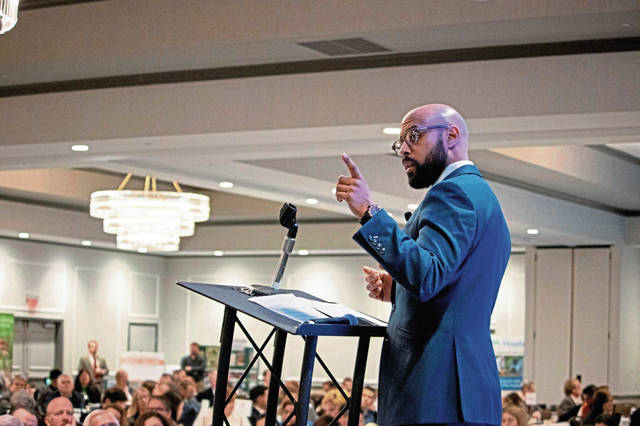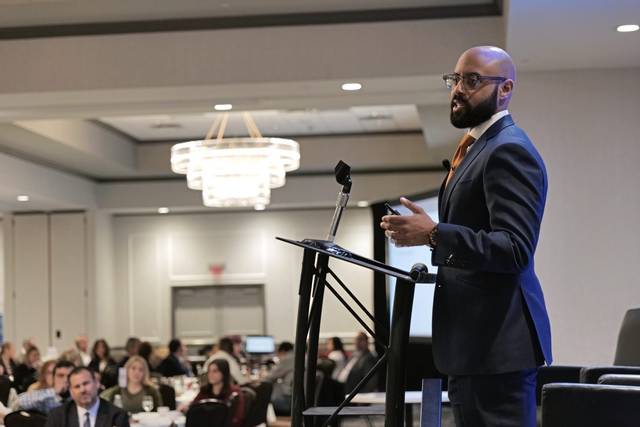Region's financial, job health focus of Washington County State of the Economy event
Despite some bright spots, the Pittsburgh region’s economy is showing signs of strain from low natural gas prices, slow job growth and a manufacturing downturn, a Federal Reserve Bank official said Thursday.
“I’m not downbeat about the longer-term prospects, but 2020 is going to be a bump in the road for us,” said Mekael Teshome, vice president of the Federal Reserve Bank of Cleveland, Pittsburgh Branch.
Speaking at the 8th annual Washington County State of the Economy event, Teshome said natural gas prices remain unprofitable at around $2 per million British thermal units and are likely to stay that way through the first half of the year.
“That means that (oil and gas) firms will likely have to scale back production, cut back on capital investment, maybe reduce head count and focus on paying down debt,” he said.
The long-term outlook for the energy sector is better, but “all told, it’s going to go through a rough year in 2020,” Teshome said.
Among those in the audience at the Hilton Garden Inn/Southpointe near Canonsburg were officials from Range Resources, EQT and other oil-and-gas companies along with Washington County elected officials and business leaders.
The employment picture for the Pittsburgh area is more of a mixed bag, Teshome said. The labor force is growing, but job growth has slowed.
“The job market remains a very strong bright spot in the U.S.,” he said. “In recent months, the jobless rate has been the lowest it’s been since the 1960s.”
The regional unemployment rate rose from 3.8% in July 2019 to 4.5% in December. “We actually saw a contraction in total employment at the end of 2019, and this ended an almost two-year streak of job gains in the region,” he said, noting that declines in manufacturing jobs are reflective of a larger national trend, although things began to even out by the end of 2019.
Industrial production grew by 2.5% in 2017 and by 3% in 2018 as manufacturers accumulated inventory to get ahead of tariff-related price increases, he said. In 2019, industrial production declined by 1.3%, but by the end of the year, things began to stabilize.
“At least it’s not declining. That’s a key upside for the economy right now,” Teshome said.
The employment picture is marred by the ongoing gap between available jobs and the available workforce, he said.
“At the national level, there are close to 6.4 million jobs posted, and there are 5.9 million unemployed people,” he said. “If anything, the biggest challenge in the labor market is difficulty finding workers. … That’s a problem that’s not likely to ease up soon without some intervention.”
Teshome said the tight job market, however, is leading to steady wage gains of 3% to 4% year-over-year. “That’s an important support to consumer spending that will keep the economy chugging forward,” he said.
Another bright spot is the fact that consumer spending remains robust. Retail sales were consistently strong throughout 2019 and “pretty good” during the Christmas shopping season, he said.
“Two-thirds of economic activity in the U.S. is consumer spending. Consumer spending is highly predictive of activity in the near term,” Teshome said.
Overall, the U.S. economy is on track for “persistent and moderate growth” in 2020, he said.
“The U.S. economy is approaching its 11th year of expansion this coming summer. That makes it one of the longest economic expansions since World War II,” Teshome said. “There are a lot of headwinds to growth, but the indicators are telling us that the expansion has durability.”
Also addressing Thursday’s gathering was Stefani Pashman, CEO of the Allegheny Conference on Community Development, and the Washington County commissioners.
Pittsburgh has been able to recover from the demise of the steel industry partly because of its diversified economy, Pashman said. But economic growth in the Pittsburgh area has not kept pace with the state or the nation, she said, noting that barriers to growth include insufficient infrastructure and inadequate transportation corridors.
“We need to do better in getting people where they need to go,” she said.
Remove the ads from your TribLIVE reading experience but still support the journalists who create the content with TribLIVE Ad-Free.


